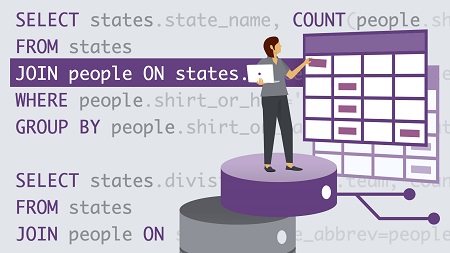
English | MP4 | AVC 1280×720 | AAC 44KHz 2ch | 1h 46m | 226 MB
Structured Query Language (SQL) is a common tool for retrieving data from relational databases such as SQL Server, MySQL, MariaDB, and PostgreSQL. This course provides an introduction to this core programming language. Learn how to request data from a database, limit and sort the responses, aggregate data from multiple tables with joins, and edit and delete data. Instructor Scott Simpson also shows how to perform simple math operations and transform data into different formats.
Topics include:
- Name the predicate of the following statement: SELECT EyeColor, Age FROM Student WHERE FirstName = ‘Tim’ ORDER BY LastName ASC;
- Explain what to use to enforce the order in which an expression must be evaluated if the WHERE clause contains multiple expressions to evaluate.
- Identify the best option to join two tables in a database to be able to display data from both.
- List a data type that is not numeric.
- Determine the result of running the following statement on a table containing columns col_1 and col_2:
INSERT INTO Box (col_1, col_2) VALUES (‘A’, ‘B’), (‘A’, ‘B’), (‘A’, ‘B’), (‘A’, ‘B’); - Determine the best approach of deleting Jon Ramirez (ID 3452) from a Student table.
Table of Contents
1 Learning SQL programming
2 Organize responses with ORDER BY
3 Find information about the data
4 Challenge- Retrieve data from the database
5 Solution- Retrieve data from the database
6 Ask for data across two or more tables
7 Understand JOIN types
8 Grouping results
9 Challenge- Practice with JOINs
10 Solution- Practice with JOINs
11 Data types in SQL
12 Exercise files
13 Math in SQL
14 Compound Select
15 Transforming data
16 Creating aliases with AS
17 Challenge- Calculate participant metrics
18 Solution- Calculate participant metrics
19 Add data to a table
20 Modify data in a table
21 Removing data from a table
22 Challenge- Practice working with data
23 Exploring DB Browser for SQLite
24 Solution- Practice working with data
25 Overcoming common SQL mistakes
26 Next steps
27 What is a database-
28 What is SQL-
29 Ask for data with SELECT
30 Narrow down a query with WHERE
31 Adding more criteria to a statement
32 Broadening and limiting responses
Resolve the captcha to access the links!